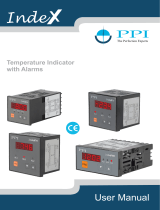
3
User Manual
Zenex Pro
BASIC OPERATIONS
Section 2
POWER-UP
Upon power-up the controller executes the following sequence of operations.
· Checks for Sensor Fault. If the connected sensor type is RTD Pt100 and the selected sensor type is any of thermocouples or
vice-a-versa; the controller displays sensor fault massage (S.FLt) on upper readout. The user is advised to take necessary
corrective action and press Enter key to acknowledge the fault.
· All displays and indicators are lit on for approximately 3 seconds to check any display segment failure.
· Displays controller model name on the Upper Readout and the firmware version on the Lower Readout, for approximately
1 second. This helps user to verify features and refer to the correct documents versions.
MAIN DISPLAY MODE
After the Power-up display sequence, the Upper Readout starts showing the Measured Temperature Value and the Lower
Readout displays the SP (Control Setpoint). This is the MAIN Display Mode that shall be used most often.
If the controller is configured to operate in PID Control Mode; the Lower Readout can be toggled to indicate either SP or %
Output Power using the ENTER Key. The default Lower Readout upon Power-up is SP. While indicating % Power, the left most
digit indicates P and remaining digits indicate power value.
Adjusting SP (Control Setpoint)
The SP value can be directly adjusted on the Lower Readout while the controller is in the MAIN Display Mode and the Lower
readout is showing SP value. If permitted at Supervisory Level, step through the following sequence for adjusting the SP
value:
1. While the Lower Readout shows SP value, press and release UP or DOWN key once. The Lower Readout starts flashing.
2. Use UP/DOWN keys to adjust the SP value.
3. Press and release ENTER key. The Lower Readout stops flashing and the new set value is registered and stored.
Tune / Optimize Indication
The controller self detects the events such as new installation, significant change in SP, etc. for auto tuning itself to the process
under control. Also, the controller can be issued ‘Optimize’ command by the user for optimization of the PID constant values.
While the controller is Tuning/Optimizing, the Lower Readout flashes the message (Busy). The user is advised not to disturb
the process or alter any parameter values while the “Busy” message is being flashed. The “Busy” message automatically
disappears upon completion of Tuning/Optimization.
Timer (Soak) Mode Indication
While Soak Timer is in progress, the front panel indicator ‘SOK’ flashes if the timer is counting down or glows steadily if the
timer is in wait / hold state.
The Lower Readout can be toggled to display either Control Setpoint (SP) or Balance Soak Time or % Output Power, using
ENTER key. While the Lower Readout shows balance soak time the indicator ‘TMR’ glows.
The Balance Soak time is in either ‘Minutes : Seconds’ or ‘Hours : Minutes’ or ‘Hours’, depending upon the time units selected
for the Soak Timer. If the selected time units are ‘Hours’, then (a) If the balance time is greater than 100 Hours, the time is
shown in ‘Hours’. (b) If the balance time is less than 100 Hours, the time is shown in ‘Hours : Minutes’.
























